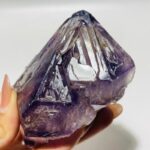In the realm of gemstones, purple holds a captivating allure, symbolizing royalty, nobility, and spiritual enlightenment. This article delves into the fascinating world of purple gemstones, specifically exploring three captivating gems: Amethyst, Tanzanite, and Charoite.

Amethyst: The Crown Jewel of Purple
Amethyst, a vibrant shade of grape purple, is the most well-known and widely used purple gemstone. This quartz variety owes its color to the presence of iron impurities, which create an optical phenomenon known as pleochroism, giving amethyst its captivating color variation from different angles.
Properties and Characteristics
- Mohs hardness: 7
- Crystal system: Trigonal
- Refractive index: 1.544-1.553
- Density: 2.65 g/cm³
Healing Properties
Amethyst has been revered for its healing properties since ancient times. It is believed to:
- Promote spiritual growth
- Enhance creativity
- Reduce stress and anxiety
- Improve sleep quality
Applications
Amethyst’s versatility makes it suitable for various applications:
- Jewelry: Amethyst is frequently used in necklaces, earrings, bracelets, and rings.
- Healing stones: Amethyst is popular for use in meditation and energy work.
- Ornamental objects: Amethyst is carved into statues, bowls, and other decorative items.
Tanzanite: A Gem of Rare Beauty
Tanzanite, an intense bluish-purple stone, is one of the world’s rarest gemstones. Discovered in the Merelani Hills of Tanzania in 1967, Tanzanite is a variety of the mineral zoisite and owes its color to the presence of vanadium.
Properties and Characteristics
- Mohs hardness: 6.5-7
- Crystal system: Orthorhombic
- Refractive index: 1.689-1.707
- Density: 3.35 g/cm³
Healing Properties
Tanzanite is believed to possess healing properties, including:
- Stimulating the third eye chakra
- Promoting intuition
- Enhancing spiritual awareness
- Relieving headaches
Applications
Due to its captivating color and rarity, Tanzanite is primarily used in jewelry, particularly in engagement rings and earrings. Its deep blue-purple hue has made it a popular choice among collectors and gemstone enthusiasts.
Charoite: A Stone of Transformation
Charoite, a mesmerizing lavender-purple stone, is a unique and relatively rare gemstone. Discovered in the Siberian village of Charo, Charoite is a complex silicate mineral that contains potassium, calcium, aluminum, silicon, and oxygen.
Properties and Characteristics
- Mohs hardness: 5-6
- Crystal system: Monoclinic
- Refractive index: 1.54-1.59
- Density: 2.70 g/cm³
Healing Properties
Charoite is believed to have powerful healing properties, including:
- Promoting emotional healing
- Facilitating spiritual transformation
- Enhancing self-awareness
- Reducing stress and anxiety
Applications
Charoite’s distinctive color and metaphysical properties have made it popular for use in:
- Jewelry: Charoite is used in necklaces, bracelets, and earrings for its vibrant lavender-purple hue.
- Healing stones: Charoite is employed in meditation and energy work for its transformative properties.
- Decorative objects: Charoite is carved into statues, bowls, and other ornamental pieces.
Comparative Analysis of Purple Gems
To provide a clearer understanding of these purple gemstones, a comparative analysis is presented below:
| Characteristic | Amethyst | Tanzanite | Charoite |
|---|---|---|---|
| Color | Grape purple | Bluish-purple | Lavender-purple |
| Hardness | 7 | 6.5-7 | 5-6 |
| Crystal System | Trigonal | Orthorhombic | Monoclinic |
| Refractive Index | 1.544-1.553 | 1.689-1.707 | 1.54-1.59 |
| Density | 2.65 g/cm³ | 3.35 g/cm³ | 2.70 g/cm³ |
| Healing Properties | Spiritual growth, creativity, stress reduction | Third eye chakra, intuition, spiritual awareness | Emotional healing, spiritual transformation, self-awareness |
| Applications | Jewelry, healing stones, ornamental objects | Jewelry, collector’s items | Jewelry, healing stones, decorative objects |
Innovative Applications for Purple Gems
The captivating properties of purple gemstones inspire innovative applications, including:
- Amethyst Nanocrystals: Tiny amethyst crystals can be synthesized for use in nanoelectronics, optics, and biotechnology.
- Tanzanite Lasers: Tanzanite’s unique optical properties make it suitable for use in lasers, offering potential applications in medicine, spectroscopy, and telecommunications.
- Charoite Energy Storage: The ability of charoite to absorb and release energy has led to the exploration of its potential in energy storage devices.
Industry Trends and Market Analysis
The global market for purple gemstones is estimated at $2 billion annually, with amethyst accounting for the largest share. Tanzanite and charoite are also gaining popularity, driven by their rarity and metaphysical properties.
Drivers of Demand
- Increasing popularity of purple as a fashion color
- Growth in spiritual and metaphysical practices
- Rising interest in rare and unique gemstones
Challenges
- Limited availability of high-quality purple gemstones
- Concerns over synthetic and treated gemstones
- Price volatility for rare gemstones
Frequently Asked Questions
-
How can you tell if a purple gemstone is real?
Consult a qualified gemologist or use a gemological testing kit to determine the gemstone’s authenticity.
-
What is the best way to clean purple gemstones?
Use a soft brush and mild soap solution, avoiding harsh chemicals or ultrasonic cleaners.
-
How should purple gemstones be stored?
Store purple gemstones separately from other jewelry in a cool, dry place, protected from light.
-
What factors affect the value of purple gemstones?
Color, clarity, cut, and carat weight are the primary factors influencing the value of purple gemstones.
-
Is it possible to find purple diamonds?
Yes, purple diamonds are extremely rare and valuable, but they are not as common as other colored diamonds.
-
What is the difference between purple amethyst and purple quartz?
Purple amethyst is a specific variety of quartz that owes its color to iron impurities, while purple quartz is a generic term for any quartz that exhibits a purple hue.




























